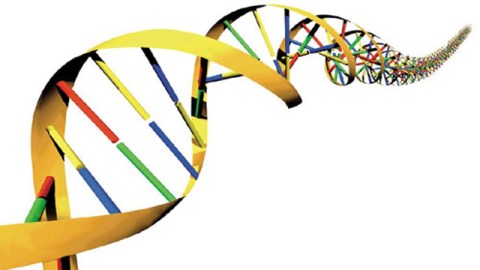#28: Create New Life Forms

What do God, Dr. Frankenstein, and Lady Gaga have in common? They are all names that geneticist-cum-media-sensation Craig Venter has been called since announcing in May that he had created the first synthetic life form.
In countless press interviews and articles, Venter detailed how he had implanted a computer-synthesized genome into an existing bacterium cell, which began making a wholly different set of proteins, causing the characteristics of the first species to disappear and a new species to emerge. This self-replicating bacterium, dubbed Synthia, is the first life form whose genome has not evolved over millions of years but was rather engineered using a computer. And of course the question du jour was whether or not this was “playing God.” But the general consensus has been “no”: Venter hasn’t actually animated a previously inanimate object, in the way that must have occurred when life first began on earth roughly 3.5 billion years ago. (Nobel prize-winning geneticist Joseph Szostak is currently trying to do just that but has failed up to this point.)
Nevertheless, this is a tremendously important breakthrough. We’ve “entered into areas where no one’s ever been before,” Venter says in the video below, and it has implications both scientific and philosophical. “It certainly changed my views of definitions of life and how life works,” he says. It is clear now that our DNA, our genetic code is like the computer software of our bodies. “Life is basically the result of an information process, a software process,” Venter explains.
Venter says the potential for this technology is extraordinary. From biofuels to helpful chemicals and food substances, he imagines a host of applications for this genetic engineering. Venter calls it a “powerful tool for what we want biology to do.” We might be able to engineer bacteria that metabolize oil in the case of oil spills like the Deepwater Horizon disaster in the Gulf of Mexico earlier this summer. Venter also says it is already being applied to the manufacture of vaccines, potentially shortening the process for making the flu vaccine each year by 99%.
Arthur Caplan, director of the Center of Bioethics at University of Pennsylvania, told Big Think that the potential benefits of Venter’s breakthrough, and synthetic biology in general, are huge. He thinks the sort of industrialized manufacturing of synthetic microbes that Venter envisions is “very plausible but very far away”—at least 10 to 20 years in the future. As with any revolutionary technology, there are of course some objections, says Caplan. Critics complain that synthetic biology (a) is too dangerous, (b) risks “playing God,” (c) could be put to bad use, or (d) is a slippery slope. But Caplan believes that we have the ability to manage these risks and that the potential benefits for humanity outweigh any fears. “Genetic engineering of microbes has been going on for a while…and we’ve managed to contain any adverse effects from their manufacture,” Caplan says.
Takeaway
Venter believes his achievement will spark a second industrial revolution in the field of biotech. Exxon Mobil has already pledged to invest $600 million to develop biofuels from algae, and that is just the beginning. We are “entering a new era where we’re only limited by our imaginations,” says Venter. As for something on the scale of synthetic humans or animals, the science is perhaps decades away—Venter’s creation has just over 1 million letters of genetic code, whereas the human genome numbers almost 3 billion. But the applications for industry and medicine remain staggering.
Why We Should Reject This
Surprisingly, the major opposition to Venter’s work hasn’t come from religious groups, many of whom have actually endorsed it. The Vatican praised this breakthrough for its potential to cure deadly diseases. Instead critics oppose Venter’s work not on philosophical grounds but rather for the potential for a man-made organism to wreak havoc on the delicate balance of earth’s ecosystems if it were to escape the lab. A synthetic species, which has not evolved on Earth over the past three billion years, might not obey the rules of the natural world. It could devastate plants and animals which would have never been been exposed to it before and would never have evolved any biological defenses to it.
Venter has assured the media that his lab has created many safeguards to protect his creations from escaping the lab, but ETC Group, a watchdog group based in Ontario and one of Venter’s most vocal critics, remains skeptical. This is a “very new and poorly understood technology,” program manager Jim Thomas tells Big Think. Venter is “claiming to be able to make assumptions about the safety of genetic biology, which as a field has never been investigated.” Similar claims were made about genetically modified plants, yet there is now widespread contamination of corn populations around the globe. “Life has a way of being rather surprising—including synthetic life,” he says.
Julian Savulescu, Director of Oxford’s Uehiro Center for Practical Ethics, agrees that Venter’s advance is “fraught with peril” and could even spell the end of humanity. “The dark side of great power is accidental calamity and human abuse,” he told the New York Daily News. “In 2001, scientists genetically modified mousepox and created a strain that killed 100% of mice. The same changes could be made to human smallpox, the greatest infectious killer in human history. Soon, terrorists will not have to get their hands on military stashes of the virus held in the former Soviet Union. With further progress in synthetic biology, it will be possible to cheaply and easily synthesize pathogens, and even modify them to make them perfectly lethal and superinfectious.”
More Resources
— “Creation of a Bacterial Cell Controlled by a Chemically Synthesized Genome” (2010) by Craig Venter, published in Science [PDF]
— Audio interview with Julian Savulescu about Venter’s breakthrough [mp3]





